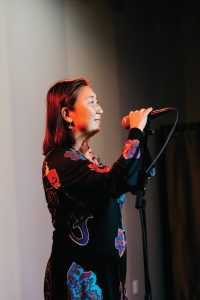
The people we met during the decade our kids attended the Orange County School of the Arts became like family. Our art school family was distraught when we heard about the sudden death of a boy in my son’s grade, Dragon Kim. Kim and his friend Justin Lee were killed by a falling tree branch while asleep in the tent on a family camping trip to Yosemite.
Our house was a hangout, and I remember many of Dragon’s friends walking around here in a daze for some time.
That was seven years ago.
“Our lives were shattered,” his mother, Grace Tsai, told me recently. “We went around like zombies for a long time. We couldn’t even work.” Tsai, a Harvard graduate who got her MBA from Stanford and worked as a marketing executive at Allergan, ConAgra Food, and Yahoo!, was unable to get out of bed to help their daughter, Hannah, get ready for school. I recalled Dragon’s dad, Daniel Kim, saying at the time that every time they thought they’d cried all their tears, more tears came.
Tsai says they were sitting in the mortuary, picking out a casket, when a friend phoned condolences. “You have your whole life to mourn Dragon,” the friend said. “Now is the time to honor him.”
Dragon played the trombone with the lightness and dexterity of a piccolo. But music was only one aspect of his character, his mom says. He was a math and science ace, a great water polo player, and he was committed, from a young age, to helping others. Just before he died, he had put together a program with OCSA administration to bring instrumental music and donated instruments to low-income children.
So his parents and Hannah—now a junior at Harvard with an interest in becoming a documentary filmmaker—thought the best way to honor him was to make that program happen.
It’s an Asian tradition for people to donate to the family at the funeral, Tsai says, and her family used that money to bring music to 200 students each year in Santa Ana.
The idea morphed into the Dragon Kim Foundation, which the Kim family created to inspire students to discover their passions and give back to their communities. The foundation has attracted several grants from major corporations. High school students are invited to design entrepreneurial projects, and the winners receive grants of $5,000 to complete them. Winning teams get intensive leadership training over three full weekends, must develop a project budget, and are connected with a business mentor.

The top three projects compete in September in the Dragon Challenge, run like “Shark Tank,” for a chance to continue their project with another $5,000. This year’s winners offered health screenings, COVID-19 vaccines, and food distribution to low-income families. Other projects have included a robotics workshop at a children’s hospital, an art show honoring the unseen work of a Holocaust survivor, sock dispensers for homeless people, a tennis camp for autistic kids, and tech skills classes for older adults. This year, nearly 300 students applied from California, Arizona, and Nevada.
One of the winning projects came from Valencia High School in Placentia—“Hoops and Coders,” a program that teaches confidence skills to young women through computer coding and basketball.
Angela DeCuir, mother of the winning project director, says her daughter Gabrielle received “an MBA in a box” with the program, especially because she was given a mentor.
“I have learned so many business, marketing, promotional, and organizational skills,” Gabrielle says. She and her fellow project winner, Shrika Andhe, both juniors at Valencia, traveled from computer to computer in a warm classroom, helping younger students develop individual apps.
“The coding is hard,” said 10-year-old Leila. “There’s a lot of buttons to press, a lot of words, and its hard learning how to connect them.” Leila was designing a storyboard that allowed users to choose a character and enter into that character’s story. “This class has helped me know I can believe in myself more. I kind of think when I grow up, I might even want to do coding as a job.”
The girls were able to find a host for their project as part of Higher Ground Youth & Family Services, a mentoring program for underserved youth. A few cubbies away, Suzette, 13, was creating an app to walk users through various sewing projects—a coin purse, a cushion cover, coasters. Suzette’s app teaches how to stitch and use tools, based on her two years of sewing experience.
“It’s not a hobby you hear much about anymore,” she says, noting that she wanted to start passing it on to a new generation.
Gabrielle says the training included public speaking exercises, which helped her become a better and more confident communicator.
The range of project ideas hascaused surprise among the judges. Tsai noted that today’s high school students are creative and entrepreneurial.
“The teenagers see how messed up our world is, and they have ideas about what they want to do, but they don’t have experience running a project team.”
I ask her whether committing herself so fully to the foundation has helped with her grief.
“To be honest, this is bittersweet for both me and Daniel,” she says. “We see how much Dragon would have loved his program, and sometimes it makes us miss him more. But sometimes, it also can feel good to that part of us that’s hurting.”
